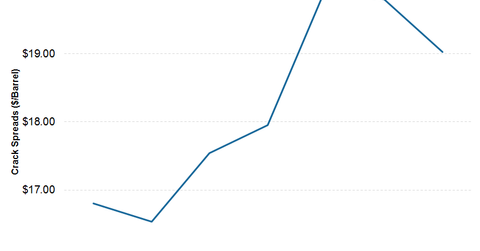What a Wider Crack Spread in Mid-May Means for American Refiners
A crack spread represents the price difference between refiners’ revenues—achieved through the sale of finished refined products—and refiner costs—that is, the price of crude oil.
Nov. 20 2020, Updated 12:08 p.m. ET

Crack spreads
The benchmark US Gulf Coast 3:2:1 crack spread rose last week, from $16.802 per barrel on May 8, to $19.026 per barrel on May 15. It hit a high of ~$20 per barrel on May 14 before falling again, yet remains higher than the previous week’s level.
The chart above represents the US Gulf Coast 3:2:1 crack spread over the last few days. It reflects a theoretical calculation for the difference between the price of two barrels of gasoline and one barrel of distillate fuel, as well as the cost of the three barrels of crude oil from which these products are assumed to be produced.
Crack spreads increase when product prices increase more than the price of crude oil, or when the price of crude oil falls more than product prices. Because last week’s increase in crude prices was lower than the increase in gasoline and diesel product prices, the weekly crack spread increased.
In the previous parts of this series, we reviewed last week’s crude and refined product price movements.
Why watch crack spreads?
Crack spreads represent the price difference between refiners’ revenues—achieved through the sale of finished refined products—and refiner costs—that is, the price of crude oil. As a result, they’re an important metric that drives refiner profitability and market valuation.
The wider the crack spread, the more profitable it is for refiners such as Valero Energy (VLO), Phillips 66 (PSX), Marathon Petroleum (MPC), and Tesoro (TSO). Together, these companies make up 4.2% of the iShares Global Energy ETF (IXC).
For more on crack spreads, read Crack Spread 101 (Part 1: What’s a crack spread?)
For the latest updates on the energy sector, read Market Realist’s Energy and Power page.
